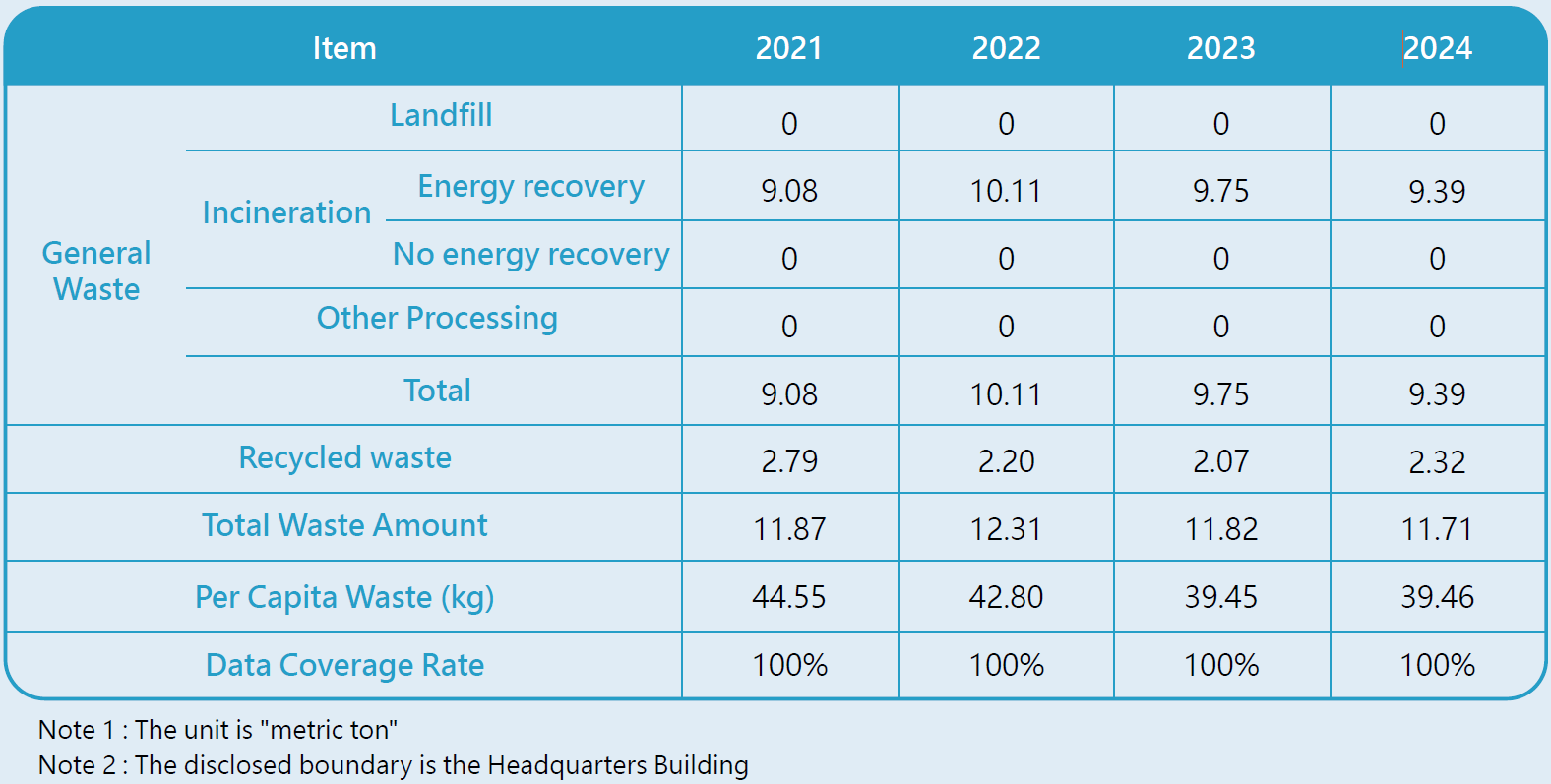Sustainable Operating Environment
Management Policies
◆ Important Regulations for Environmental Management
KTB has formulated the "Sustainable Development Best Practice Principles," which was approved by the Board of Directors, , as the principle to develop its sustainability, which has been disclosed on KTB's official website. KTB has also formulated the "Energy Conservation and Environmental Protection Standards Implementation Guidelines" and "Energy Operation Control Manual" as the principles for the promotion of environmental protection and energy conservation.
◆ Environment Management Framework
We take initiative to set the reduction goal and employs third-party verification to review the achievement condition. At the time of implementation, KTB regularly reviews the energy consumption (water, electricity, greenhouse gas, etc.) of the whole bank compared to the same period last year, as well as monthly reviews the water and electricity consumption of each business unit for any irregularities, and reports the findings to the ESG Team meeting, so as to implement sound environmental management. In response to the global trend toward net-zero emissions by 2050, we have also established concrete net-zero targets. Through tangible actions, we aim to reduce our carbon footprint and enhance our competitiveness in the market, working collectively to address the challenges of climate change.
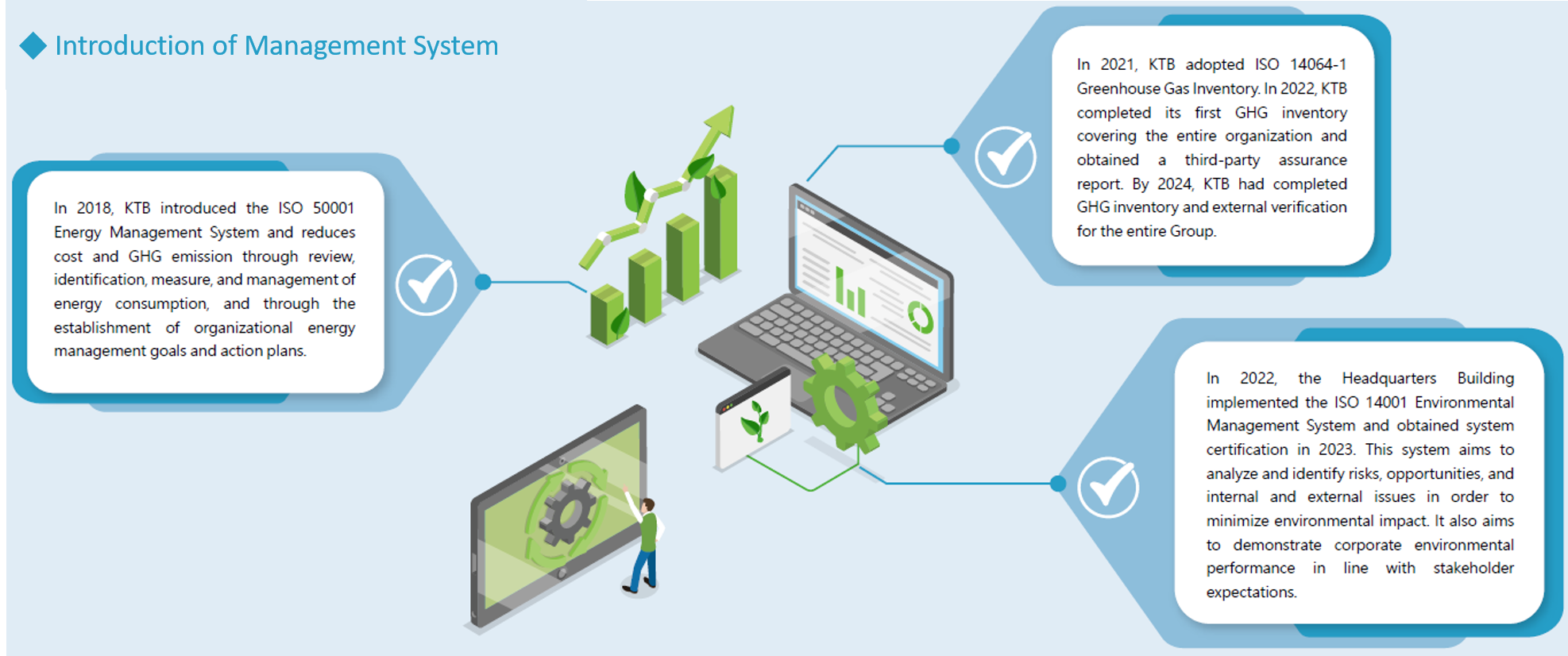
Net Zero Planning
Confronted with the trend of net zero emission internationally, the Company formulated four strategies from the aspects of internal operation and investment and financing positions, respectively, to reduce our own carbon emission from operation, and we also make review every year to achieve the goal of net zero gradually.
1. Implementation of carbon reduction plans: Continuously reduce carbon emissions in operational processes
2. Greenhouse gas inventory: Understanding the Greenhouse Gas Emissions in the Operational Process
3. External verification: Verify the data obtained through rigorous methods of investigation
4. Set carbon reduction/net-zero goals: Based on rigorous and scientific data, set net zero goals and consistently implement practical carbon reduction measures.
In addition to internal operation, it's estimated by us that the project of the largest carbon emission is the emission by investment and financing customers in Scope 3 (include all other indirect emissions). However, small and medium-sized enterprises (SMEs) have many difficulties in executing inventory and disclosure of relevant data, requiring assistance by financiers very much. To solve this problem, KTB is planning to assist with SME financing customers in making carbon inventory. This action can not only help KTB have a more comprehensive understanding of the total carbon emissions from the investment and financing positions, but also enable the SMEs not to be neglected in the carbon reduction topic nowadays.

KTB's Net-Zero Target and Renewable Energy Usage
KTB has established a net-zero emissions goal with the objective of achieving net-zero emissions by 2050. In line with the principles of the Science Based Targets initiative (SBT), the Bank has set net-zero targets for Scope 1 and Scope 2 emissions. Using 2023 as the baseline year, the Bank aims to reduce carbon emissions by 4% each year compared to the previous year, with 3% of this reduction derived from the use of renewable energy and 1% from self-managed carbon reduction efforts. We are committed to achieving net-zero emissions by 2050. The Company's environmental data are recorded monthly or quarterly by the responsible departments and reported to the ESG Task Force, which convenes quarterly to monitor progress. Additionally, results are reported to the Sustainable Development Committee and the Board of Directors half-yearly. In support of green energy policies, the Company began preparations in 2011 to install a rooftop solar power system at its Headquarters. With an installed capacity of 9.87 kW, the system was connected to the grid in 2012. Since then, the Company has continued to identify suitable branch locations to expand its green electricity generation capacity. Furthermore, starting in 2024, the Company began purchasing renewable energy from electricity retailers. In 2024, renewable energy usage reached 137,000 kWh, reducing greenhouse gas emissions by 67.68 tCO2e and successfully meeting the annual target. In the future, the Company plans to increase its renewable energy usage by approximately 120,000 kWh annually to further raise the proportion of renewable energy in its overall consumption.
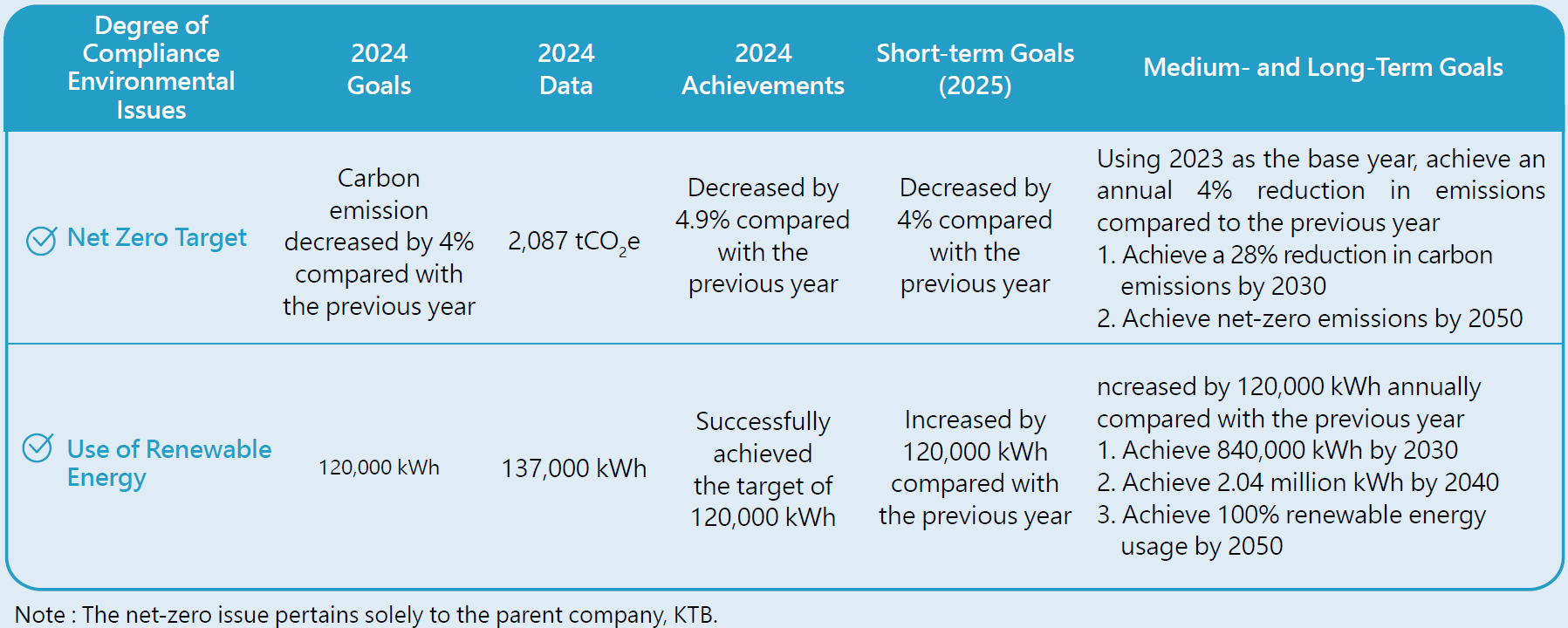
Entire Group Environmental Targets
KTB has set environmental targets with the objective of minimizing the environmental impact arising from its operations. The Company‘s environmental data are recorded monthly or quarterly by the responsible departments and reported to the ESG Task Force, which convenes quarterly to monitor progress. Additionally, results are reported to the Sustainable Development Committee and the Board of Directors half-yearly. The targets set for greenhouse gas management, energy management, and water resource management were all achieved in 2024. The boundary for waste management data is limited to the Headquarters building. Although general waste at the Headquarters decreased by 3.71% compared to the previous year, the 2024 target was not met due to the increase in cardboard recycling. This was primarily driven by the “Circular Treasure Festival” charity sale activity, where donations were collected from 66 branches and three subsidiaries, as well as the frequent gift-giving during the holiday season. In response, the Company has strengthened internal awareness campaigns, encouraging employees to reuse cardboard boxes and adjust their consumption behavior by reducing purchases of excessively packaged goods to alleviate environmental impact. The Company will continue to track related waste data to ensure further progress.

Note 1: The data of Scope 1 and Scope 3 in 2021 were only based on the verification data of the Headquarters Building, which were 95.5265 and 16.8375 respectively. The data of Scope 2 includes the inspection data of the Headquarters Building, plus the self-inspection data of 66 branches (unit: t-CO2e).
Note 2: Based on verified data for the Entire Bank in 2022 and 2023, Scope 1 emissions data covers the Entire Bank, resulting in a significant increase compared to 2021 (where boundaries were limited to the Headquarters Building only); the 2024 verified data covered the entire Group
Note 3: Assurance Scope for 2022 and 2023: Scope 1 to 3 (covering the Entire Bank). Assurance Scope for 2024: Scopes 1 to 3 (covering the entire Group). The assurance work was planned and performed by Ernst & Young Certified Public Accountants in accordance with engagement number 3410, "Assurance Engagement on Greenhouse Gas Statement," and resulted in a limited assurance conclusion
Note 4: The data of Scope 1 mainly include data from official vehicle oil, liquefied petroleum gas (LPG), generator diesel and refrigerant.
Note 5: Scope 1 emission is based on the "Greenhouse Gas Emission Factor Management Table" version 6.0.4 issued by the Ministry of Environment, Executive Yuan, and the global warming potential (GWP) is based on the "Climate Change 2021" IPCC Sixth Assessment Report.
Note 6: Scope 2 annual emission is based on the announcement by the "Bureau of Energy, Ministry of Economic Affairs." The 2024 electricity carbon emission factor is based on 2023's factor, which was 0.494KgCO2e/kWh
Note 7: Scope 3 for 2022-2024 includes purchased goods and services. Scope 3 for 2021 included purchased goods and services, capital goods, and waste generated from operations
Note 8: According to ISO 14064-1, the organization's greenhouse gas inventory standard, emissions = activity data × emission factor × global warming potential (GWP)
Note 9: The greenhouse gas inventory adopts the "Operational Control Approach" to aggregate data
Water Resources Management
100% of the water used in KTB's operations comes from the Taiwan Water Corporation and Taipei Water Department, and no groundwater or other water sources are used. The water used in all office buildings and operating sites is only for employees and some customers. There is no significant impact to the water source and is mainly used for drinking, air conditioning systems, cleaning, and other purposes. The wastewater is then discharged through the sewage system. Facing Taiwan's increasingly severe water shortage, we have set reduction targets. We prioritize purchasing products with the water-saving label, conduct monthly reviews of water usage across the Headquarters and its Business Units for any anomalies, report water-saving achievements quarterly in the ESG Team, present water-saving outcomes semi-annually to the Sustainable Development Committee and the Board of Directors, and periodically educate employees on proper water usage practices.
To reduce water usage, the Company actively implemented proactive controls in 2024 to manage water consumption at each operational site. We introduced water-saving initiatives, integrating water usage at operational sites with performance evaluations and used incentives and penalties to ensure that water-saving awareness. The actions are implemented by every team member. In 2024, KTB achieved notable water conservation results, reducing water consumption by 2.09 cubic meters compared to the previous year. Although the scope of the audit was expanded to cover the entire Group and the total number of employees increased, resulting in a total water usage rise of 448 cubic meters, the per capita water consumption decreased by 10.25% year over year. This indicates that the Company’s proactive control measures have proven effective. Building on this achievement, we plan to continue promoting water-saving initiatives linked to performance evaluations in 2025, with the goal of further reducing overall water consumption.
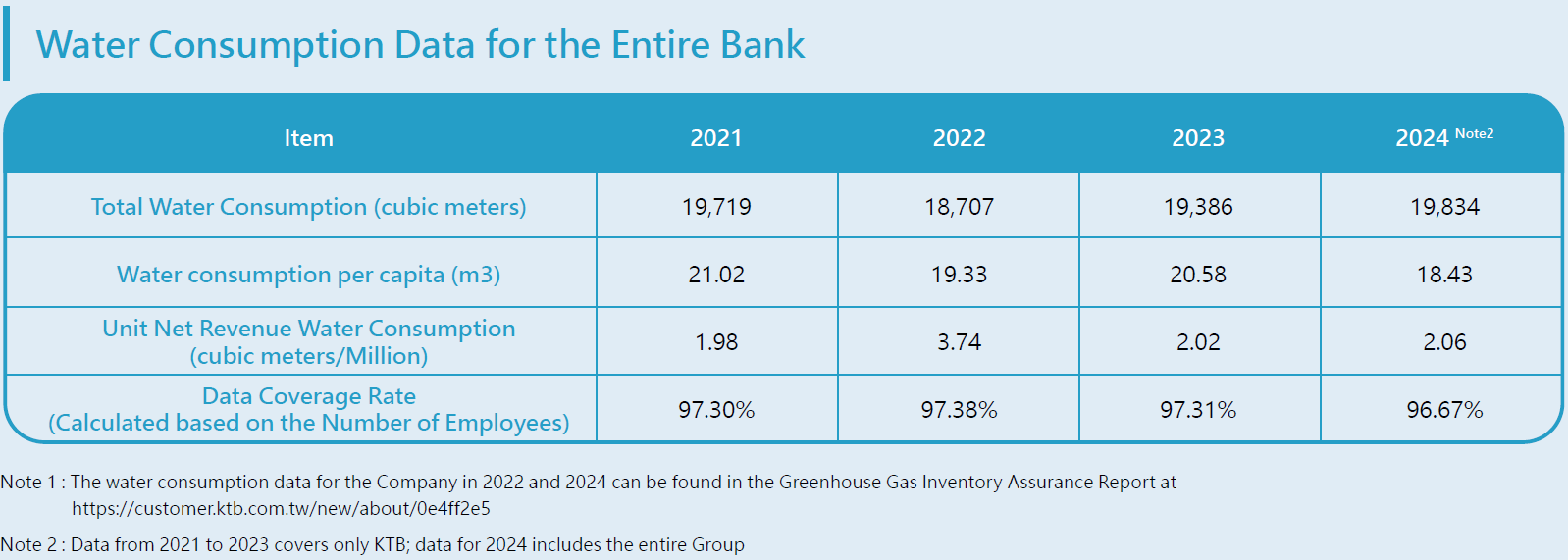
GHG Management
KTB's main GHG emissions are from electricity consumption. Thus, we have set forth special energy-conservation plans for light fixtures, air conditioners, computer room, and elevators, and we have also set a goal of reduction. In 2024, the disclosure boundary was expanded from the entire Bank to the entire Group, resulting in an increase in Scope 1 and Scope 2 emissions. However, the per capita emissions amounted to 2.00 tCO2e, representing an 11.89% reduction compared to the previous year, successfully achieving the reduction target.
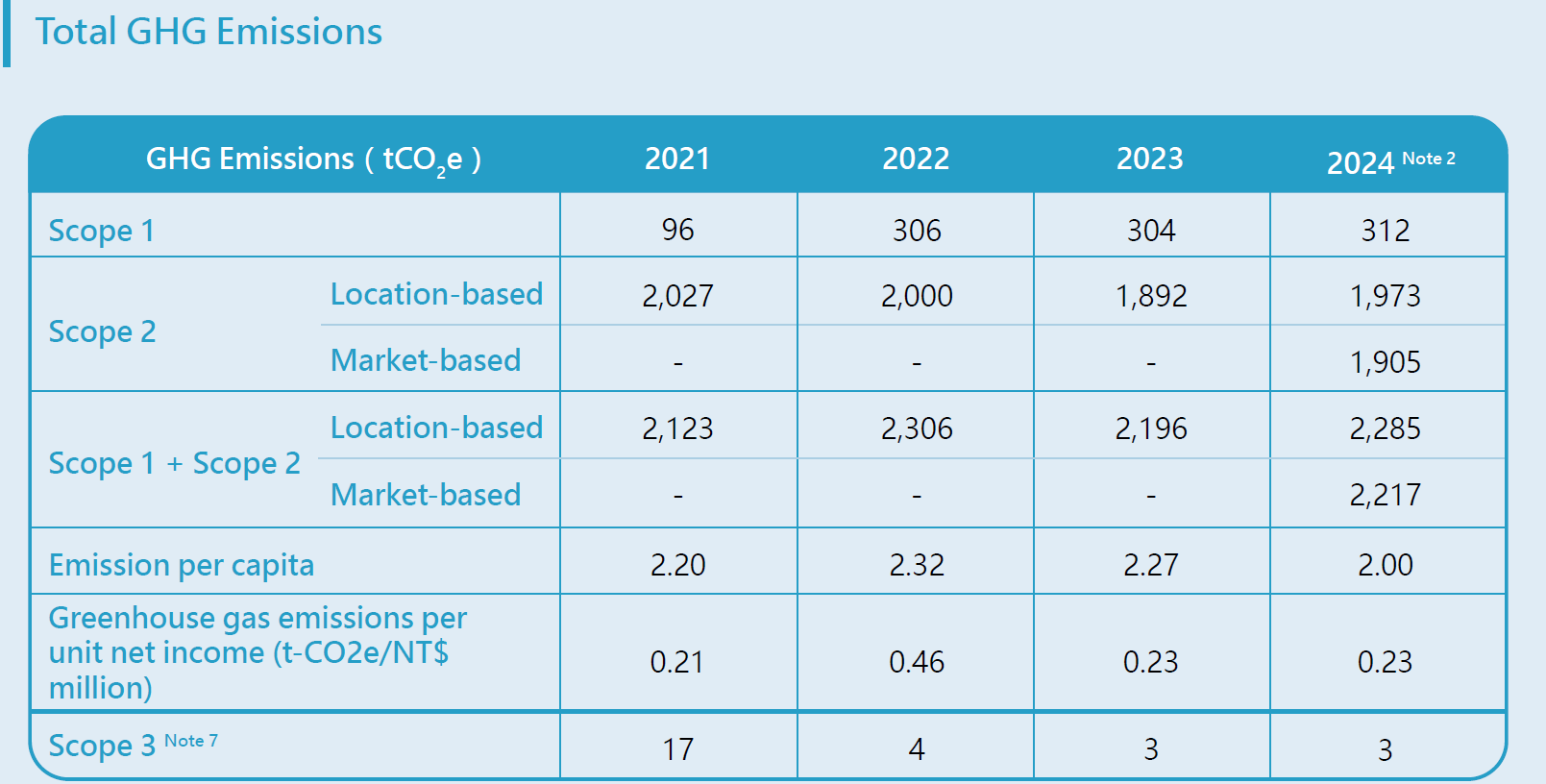
Greenhouse Gas Strategy and Specific Action Plan
V Please refer to the net zero strategy for greenhouse gases, please refer to page 72.
V Specific Action Plan
In pursuit of the goal of sustainable environmental management, KTB has implemented the ISO 14001 Environmental Management System and the ISO 50001 Energy Management System to reduce environmental pollution risks and improve energy efficiency. Internally, the Bank has also issued the "Sustainable Development Best Practice Principles," the "Implementation Guidelines for Energy Conservation and Environmental Protection Behavior," and the "Energy Operation Control Manual" as specific action guidelines to promote environmental protection and energy conservation.
In order to effectively reduce greenhouse gas emissions, our Company has formulated the following energy-saving measures:
1. Procured renewable energy sources and installed solar panels for self-use.
2. Newly installed and replaced lighting fixtures are fully equipped with energy-saving LED light fixtures.
3. The Bank installed variable speed air conditioners, which as a constant temperature control device, and sets the average indoor air temperature at no lower than 26 degrees Celsius.
4. Adjust computer room space configuration and reorganize wiring to improve energy efficiency in the computer room.
5. Regulate the billboard light on and off time period according to the daylight time and season.
6. The use of some elevators will be suspended during non-peak hours.
7. Electrical appliances or equipment, such as photocopiers, shredders, computers, lights, elevators, etc., are set to sleep, standby, or auto-sensing functions.
8. Prioritize purchasing products with the Water Efficiency Label and promote the correct concept of water usage.
9. Reduce the use of plastic or disposable utensils and cups, and implement proper waste sorting and resource recycling.
10. Promote digital transactions and paperless operations, and encourage double-sided printing and paper recycling.
11. Join the green procurement campaign to support low-carbon products, green building materials, and sustainable goods enterprises.
In 2024, 137,300 kWh of green electricity were utilized, accounting for approximately 3.43% of the total electricity consumption for that year. In the future, the Company plans to increase this usage by 120,000 kilowatt-hours annually and will continue to assess suitable branch locations to expand the solar power generation system, gradually enhancing the proportion of renewable energy usage.

Internal Carbon Pricing
To reduce carbon emissions during operations and achieve a self-imposed net zero target of a 1% reduction, KTB has implemented an energy-saving program for its business units starting in 2024. This program will integrate the electricity and water savings of each operational site with performance evaluations, rewarding those business units that demonstrate superior energy-saving results. The Company adopts an implicit price for carbon by calculating the cost of replacing air conditioning equipment and the associated carbon savings. The price for one ton of carbon is set at NT$6,000, which serves as the internal carbon price for evaluating the effectiveness of various energy-saving and carbon-reduction initiatives undertaken by our business units. We convert the amount of electricity and water saved into carbon reduction equivalents, which are subsequently translated into monetary value to reflect the benefits of carbon reduction. In 2024, across the entire Bank, based on market fundamentals, Scope 1 and 2 were collectively reduced by 108 tons, resulting in an estimated savings of 648,000 in carbon pricing costs.
However, the scope of the inventory for 2024 has expanded to encompass the entire group, resulting in an overall increase of 21.53 tons in GHG emissions. In the future, the Company will continue to implement energy and water conservation projects and strengthen the promotion of internal carbon pricing. Through increased employee training and education, we aim to start with each employee and collectively work towards reducing carbon emissions during our operational processes. The Company will adopt internal carbon pricing as a preliminary tool to simulate the cost-effectiveness of energy-saving measures. This approach will support the evaluation of financial risks and feasibility for operational sites or future investment projects, thereby gradually enhancing the Company's ability to identify and manage climate-related financial risks.
Energy Management
The electricity used in the operating process of KTB is mainly externally purchased electricity (renewable energy and non-renewable energy), and a small part of it is gasoline and liquefied petroleum gas. For the use of energy, KTB has introduced the ISO 50001 Energy management system to effectively improve energy efficiency and reduce electricity consumption. Please refer to the greenhouse gas strategy and specific action plan for further details on the measures.
In order to promote employees' actions and awareness of climate changes and energy conservation, we regularly organize educational training sessions to remind all employees to participate. In addition to regular training programs, in 2024 we further promoted a source reduction initiative by linking electricity savings at each operating site with performance evaluations, aiming to further reduce electricity consumption across our operations. In 2024, the Bank’s total electricity consumption was approximately 3.75 million kWh, representing a 1.88% decrease compared to the previous year. Although the total electricity usage increased due to the expansion of the inventory boundary to cover the entire group, the per capita consumption was 3,594.39 kWh, marking an 8.95% reduction from the previous year and successfully achieving the reduction target. In 2025, we will continue implementing electricity conservation initiatives linked to performance evaluations, with the goal of further reducing electricity consumption.
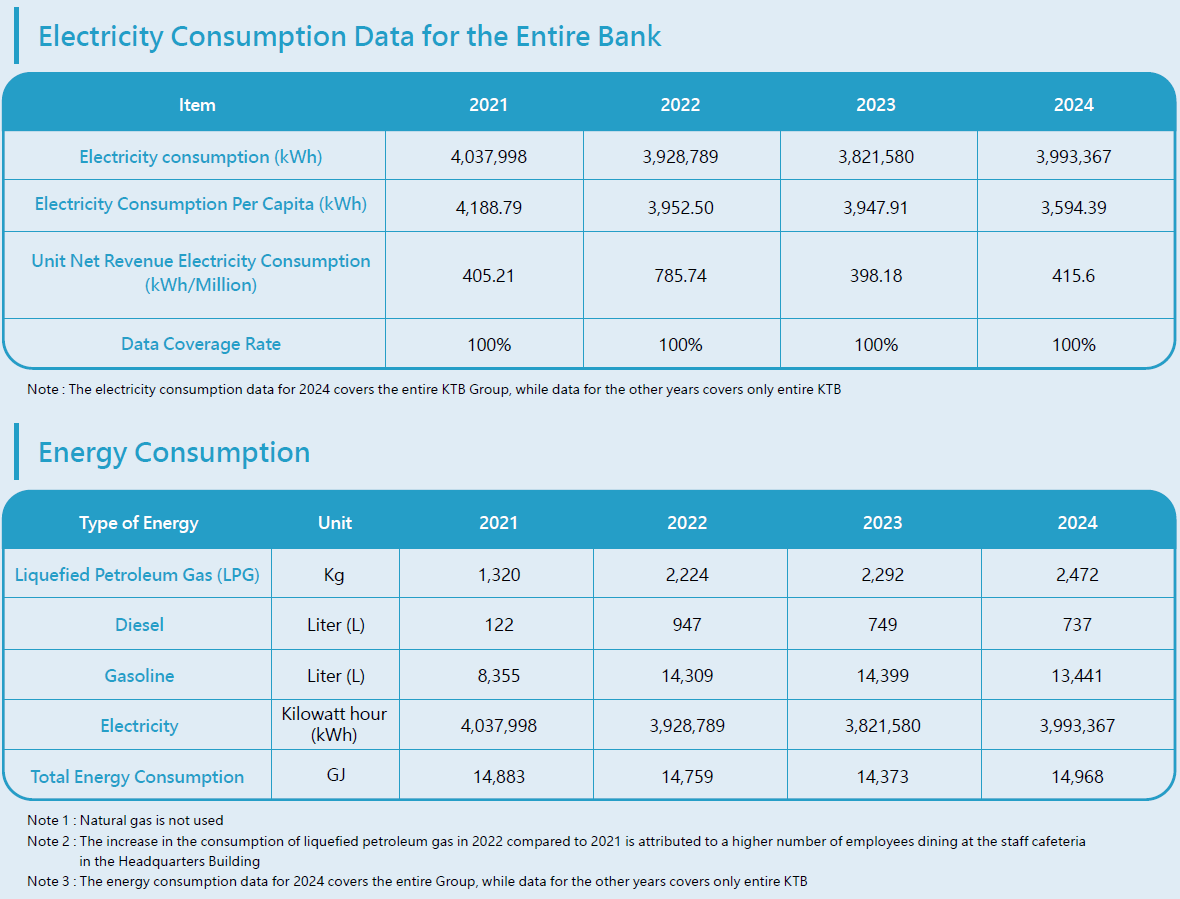
Waste Management
KTB has long had the awareness of waste reduction. Disposable tableware was never used in the employees' canteen in the Headquarters Building. All kinds of disposable utensils were not actively provided when the canteen was renovated in 2010. This policy has effectively reduced the use of 150,000 paper containers. In addition, for inevitable wastes, KTB separates the waste into general waste (including kitchen wastes) and recycled waste to increase the recycling rate. In order to track and manage the situation of waste management in the Headquarters Building, all the wastes were weighed before disposing, since November 2018. The data for waste treatment in the past four years are shown in the below table.
KTB has set a five-year reduction target (please refer to the Environmental Targets). To minimize the environmental impact of our operations, we have implemented two key measures: "eliminating personal trash bins" and "prohibiting the use of disposable tableware for takeout in the staff cafeteria." Although general waste in 2024 decreased by 3.71% compared to the previous year, the total volume of waste increased. This was primarily due to the “Circular Treasure Festival” charity sale organized by the Company, during which materials were collected from 66 branches and 3 subsidiaries, leading to an increase in cardboard box recycling. Additionally, the frequent exchange of gifts during the holiday season further contributed to the rise in cardboard waste. In response, the Company has strengthened internal communication to encourage employees to reuse cardboard boxes and adopt more sustainable consumption practices by avoiding excessively packaged products. We will continue to monitor waste data to reduce our environmental footprint.
